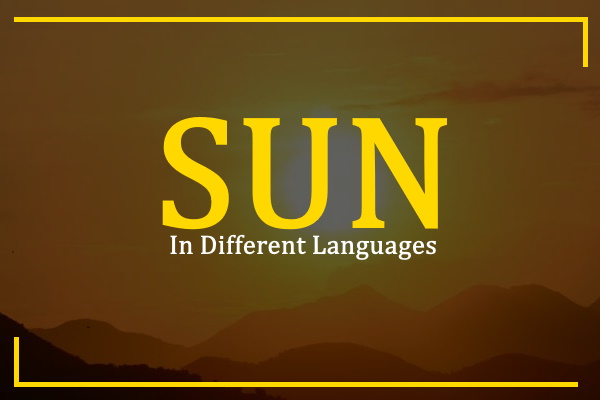Table of Contents
Sun in Different Languages: Sun is a star at the middle of solar system which is the heart of solar system with a sphere of hot plasma. It is the most important source of energy for earth that contains more than 99% mass of the solar system. The Sun is about 70% hydrogen and 28% helium; everything else is less than 2%. Sun and Earth deal with the seasons, sea waves, environment, atmosphere, radiation belts and aurora.
Sun in European Languages
Translation of word Sun in almost 42 European languages.
| Different Languages | Word Sun |
|---|---|
| Albanian | diell |
| Basque | eguzkia |
| Belarusian | сонца |
| Bosnian | sunce |
| Bulgarian | слънце |
| Catalan | sol |
| Corsican | sole |
| Croatian | sunce |
| Czech | slunce |
| Danish | sol |
| Dutch | zon |
| Estonian | päike |
| Finnish | aurinko |
| French | Soleil |
| Frisian | sinne |
| Galician | sol |
| German | Sonne |
| Greek | ήλιος [ílios] |
| Hungarian | nap |
| Icelandic | Sól |
| Irish | ghrian |
| Italian | sole |
| Latvian | saule |
| Lithuanian | saulė |
| Luxembourgish | Sonn |
| Macedonian | сонцето |
| Maltese | xemx |
| Norwegian | sol |
| Polish | słońce |
| Portuguese | dom |
| Romanian | soare |
| Russian | солнце [solntse] |
| Scots Gaelic | ghrian |
| Serbian | сунце [sunce] |
| Slovak | slnko |
| Slovenian | sonce |
| Spanish | sol |
| Swedish | Sol |
| Tatar | кояш |
| Ukrainian | сонце [sontse] |
| Welsh | haul |
| Yiddish | זון |
Sun in Asian Languages
Translation of word Sun in almost 36 Asian languages.
| Different Languages | Word Sun |
|---|---|
| Armenian | արեւ |
| Azerbaijani | günəş |
| Bengali | সূর্য |
| Chinese Simplified | 太阳 [tàiyáng] |
| Chinese Traditional | 太陽 [tàiyáng] |
| Georgian | მზე |
| Gujarati | સૂર્ય |
| Hindi | रवि |
| Hmong | hnub |
| Japanese | 太陽 |
| Kannada | ಸೂರ್ಯನ |
| Kazakh | күн |
| Khmer | ព្រះអាទិត្យ |
| Korean | 태양 [taeyang] |
| Kyrgyz | күн |
| Lao | ດວງອາທິດ |
| Malayalam | സൂര്യൻ |
| Marathi | सूर्य |
| Mongolian | нар |
| Myanmar (Burmese) | နေ |
| Nepali | सूर्य |
| Odia | ସୂର୍ଯ୍ୟ |
| Pashto | لمر |
| Punjabi | ਸੂਰਜ |
| Sindhi | سج |
| Sinhala | හිරු |
| Tajik | офтоб |
| Tamil | சூரியன் |
| Telugu | సూర్యుడు |
| Thai | ดวงอาทิตย์ |
| Turkish | Güneş |
| Turkmen | gün |
| Urdu | سورج |
| Uyghur | قۇياش |
| Uzbek | quyosh |
| Vietnamese | mặt trời |
Sun in Middle East Languages
Translation of word Sun in 4 middle eastern languages.
| Different Languages | Word sun |
|---|---|
| Arabic | شمس [shams] |
| Hebrew | שמש |
| Kurdish (Kurmanji) | tav |
| Persian | آفتاب |
Sun in African Languages
Translation of word Sun in almost 13 African languages.
| Different Languages | Word Sun |
|---|---|
| Afrikaans | son |
| Amharic | ፀሐይ |
| Chichewa | dzuwa |
| Hausa | rãnã |
| Igbo | anyanwụ |
| Kinyarwanda | izuba |
| Sesotho | letsatsi |
| Shona | zuva |
| Somali | qorraxdu |
| Swahili | jua |
| Xhosa | ilanga |
| Yoruba | oorun |
| Zulu | ilanga |
Sun in Austronesian Languages
Translation of word Sun in almost 10 Austronesian languages.
| Different Languages | Word Sun |
|---|---|
| Cebuano | adlaw |
| Filipino | araw |
| Hawaiian | lā |
| Indonesian | matahari |
| Javanese | sun |
| Malagasy | masoandro |
| Malay | matahari |
| Maori | ra |
| Samoan | la |
| Sundanese | panonpoé |
Sun in Other Foreign Languages
| Different Languages | Word Sun |
|---|---|
| Esperanto | sunon |
| Haitian Creole | solèy |
| Latin | solis |
Video Translation of Sun in 10 Other Languages

Arslan Hussain, founder of The Different Languages, is an experienced translator passionate about languages and cultures. Through his website, he shares his knowledge and love for different languages, making learning accessible and enjoyable.

